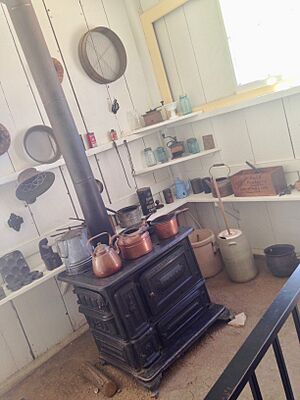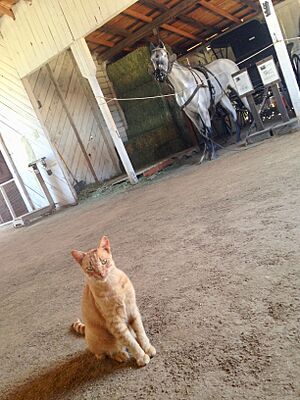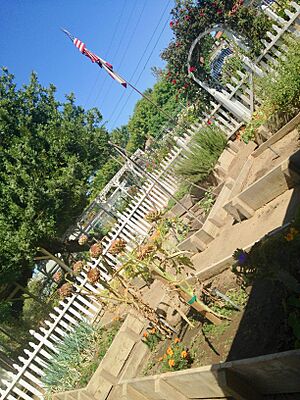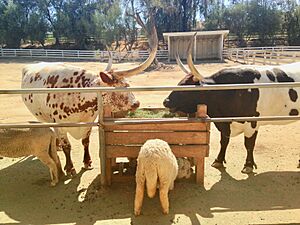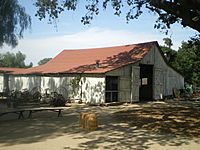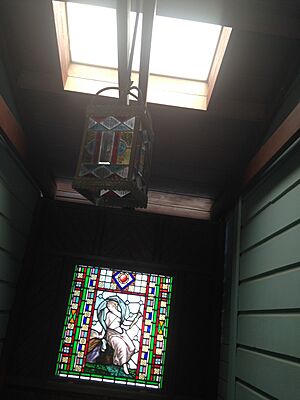Leonis Adobe facts for kids
|
The Leonis Adobe
|
|
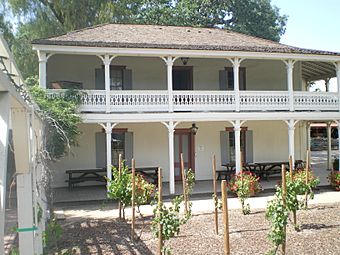
The Leonis Adobe, 2008
|
|
| Lua error in Module:Location_map at line 420: attempt to index field 'wikibase' (a nil value). | |
| Location | 23537 Calabasas Rd., Calabasas, California |
|---|---|
| Built | 1844 |
| Architectural style | Monterey Colonial, Adobe, Queen Anne |
| NRHP reference No. | 75000433 |
Quick facts for kids Significant dates |
|
| Added to NRHP | May 29, 1975 |
The Leonis Adobe is a very old and important house located in Calabasas, California. It's one of the oldest homes still standing in Los Angeles County and one of the oldest buildings in the San Fernando Valley. It was built in 1844. A rich rancher named Miguel Leonis lived there until he passed away.
After Miguel Leonis died, there was a long legal disagreement over who would own the property. This dispute involved his partner, Espiritu Chijulla, and lasted for more than 15 years in court.
In 1961, the adobe was in bad shape. Its owner wanted to tear it down to build a supermarket. But people who cared about history stepped in! They managed to get the adobe declared Los Angeles Historic-Cultural Monument #1 in 1962. This saved it from being destroyed at the very last moment. It was later added to the National Register of Historic Places in 1975.
Today, the Leonis Adobe has been carefully fixed up. It is now a special museum where you can learn about life in the past.
Contents
History of the Adobe
How the Adobe Started
The first part of the Leonis Adobe was built in 1844. We don't know much about what it was used for before Miguel Leonis bought it. Some stories say it was a stop for stagecoaches. These coaches traveled on the Camino Real road between Mission San Buenaventura and Mission San Fernando Rey de España.
Miguel Leonis and His Ranch
Miguel Leonis (1824–1889) bought the adobe in the 1850s or 1860s. He was a tall man from a region in France called the Northern Basque Country. Miguel Leonis owned a lot of land in the western part of the San Fernando Valley and some of Ventura County.
The adobe was built in different stages. By the 1870s, Leonis had made the house much bigger. He changed it into the beautiful Monterey Colonial-style mansion you see today. He added more rooms by enclosing the porches. He also added a fancy Queen Anne-style porch to the front of the house.
Miguel Leonis started out working on a ranch. He later bought half of the 1,100-acre (4.5 km2) Rancho El Escorpión. The other half was owned by Espiritu Chujilla, a Native American woman. Leonis and Espiritu lived together and managed a very large ranch.
He added to his land by using California's homestead laws. He had many employees who helped him claim more land. Leonis and his ranch hands often had disagreements with people who tried to settle on his property. By the time he passed away, he owned a huge amount of land and was very wealthy.
Espiritu Chujilla and the Legal Battle
In 1889, Miguel Leonis died after falling from his wagon. After his death, his will was read. It said that Espiritu Chujilla was his "faithful housekeeper" and left her only $10,000. The rest of his money was left to his family. Many people were surprised because Espiritu had been considered his partner for almost 30 years.
Espiritu challenged the will in court. This led to many years of legal battles. In 1891, Espiritu had 40 witnesses who said that Leonis had publicly called her his wife. Espiritu herself testified that she had lived with Leonis for 30 years. She even said they had a daughter together who passed away when she was young. The daughter's grave, which named Leonis as the father, was used as proof of their relationship.
After a five-week trial, the jury decided in favor of Espiritu. She was awarded half of Miguel Leonis's large estate.
However, Espiritu's legal problems continued. Other people tried to claim parts of the land. Some dishonest people also tried to take advantage of Espiritu, who was not formally educated. It was said that at one point, she had very little money because her property was tied up in court cases.
Espiritu continued to live at the adobe until she passed away in 1906.
From the 1910s to the 1940s
After Espiritu died, her son, Juan Menendez, moved into the adobe with his family. Juan Menendez built the barn that you can still see behind the adobe today. He was a blacksmith and also made wine. He built a special tank house at the adobe to store his wine.
Menendez sold the property in 1922 to the Agoure family. The town of Agoura is named after them. The Agoures updated the house in 1920, adding bathrooms and making the living room bigger. The Agoures lost the property in 1931. After that, the adobe was used as a restaurant and later as a retirement home.
Saving the Adobe
Around 1950, a company bought the land where the Leonis Adobe stood. This company planned to build new homes around the adobe. At first, they said they would fix up the adobe.
But by 1961, a new owner wanted to tear down the adobe. He planned to build a shopping center there. People who wanted to save the adobe started petitions. They worked to get the building recognized as a protected landmark.
While the plans to demolish the adobe were being discussed, vandals damaged the building. Windows were broken, walls were shattered, and doors were torn off. The Leonis Adobe Association offered to put up a fence to protect the adobe, but the owner refused. He said he was going to tear it down anyway.
In August 1962, the owner's request to demolish the adobe was denied. The new City of Los Angeles Cultural Heritage Board officially named the adobe as the city's very first Historic-Cultural Monument. This decision helped start a bigger conversation about saving historical buildings in the San Fernando Valley.
It was hard to find enough money to buy the adobe from its owner. But in March 1963, a woman named Kay Beachy paid the $240,000 needed to buy the property. Mrs. Beachy agreed to hold onto the property until the Leonis Adobe Association could buy it from her. The mayor even gave her an award for helping to save the adobe!
Restoring the Adobe
The Leonis Adobe Association finally raised enough money to buy the property in 1965. A lot of research was done to make sure the adobe looked just like it did when Miguel Leonis lived there. After all the restoration work was finished, the adobe opened to the public in 1966.
Ghost Stories at the Adobe
Some people believe the Leonis Adobe is haunted! Stories of Miguel Leonis's ghost appearing at the adobe began in the 1920s. This was when new people moved into the house and started to fix it up.
According to one story, the new residents heard footsteps on the stairs. Then they heard two loud thuds from an upstairs bedroom, like boots dropping. When they checked, the room smelled strongly of soap. Miguel Leonis was known for always being very clean and smelling of soap. The noises continued, and the new owners learned to live with what they thought was the ghost of the former owner.
Another legend says that in the 1930s, a woman living there was saved by a ghost. She was leaning against a railing that cracked, and something pulled her back, stopping her from getting hurt. Other tales include a guest seeing an image in the hallway that spoke in a female voice. Some people claim to hear digging sounds at the adobe. Legend says Leonis kept his fortune hidden there.
Historic Site Recognition
The Leonis Adobe is one of only four adobe homes still standing in the San Fernando Valley. It has been recognized as an important historic building at both the city and national levels:
- When the Los Angeles Cultural-Historical Board was created in 1962, the Leonis Adobe was the very first site they officially recognized. It has the special title of Historic-Cultural Monument #1.
- In 1975, the adobe was added to the National Register of Historic Places.
Leonis Adobe Museum
A Living History Museum
Today, the Leonis Adobe operates as a living history museum. It shows what life was like on a California ranch. The museum is a popular place for school field trips. Students can step back in time to the 1880s. They tour the property and take part in activities that show how people lived back then. Students can also pet, feed, and watch the ranch animals with museum guides.
The Plummer House
| Plummer House | |
|---|---|
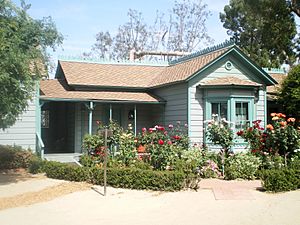
Plummer House, 2008
|
|
| Built | 1874 |
| Architect | Eugene Raphael Plummer |
| Designated | January 11, 1935 |
| Reference no. | 160 |
In 1983, another historic building called the Plummer House was moved to the grounds of the Leonis Adobe Museum. The Plummer House was built in 1874 in West Hollywood. It was known as the "Oldest House in Hollywood." It was also named a California Historic Landmark in 1935.
Over time, the Plummer House fell apart and was damaged. The Leonis Adobe Association worked with others to move part of the Plummer House to its current spot at the adobe. The Plummer House has been restored. It is now used as the visitor center and gift shop for the Leonis Adobe Museum.
Images for kids


